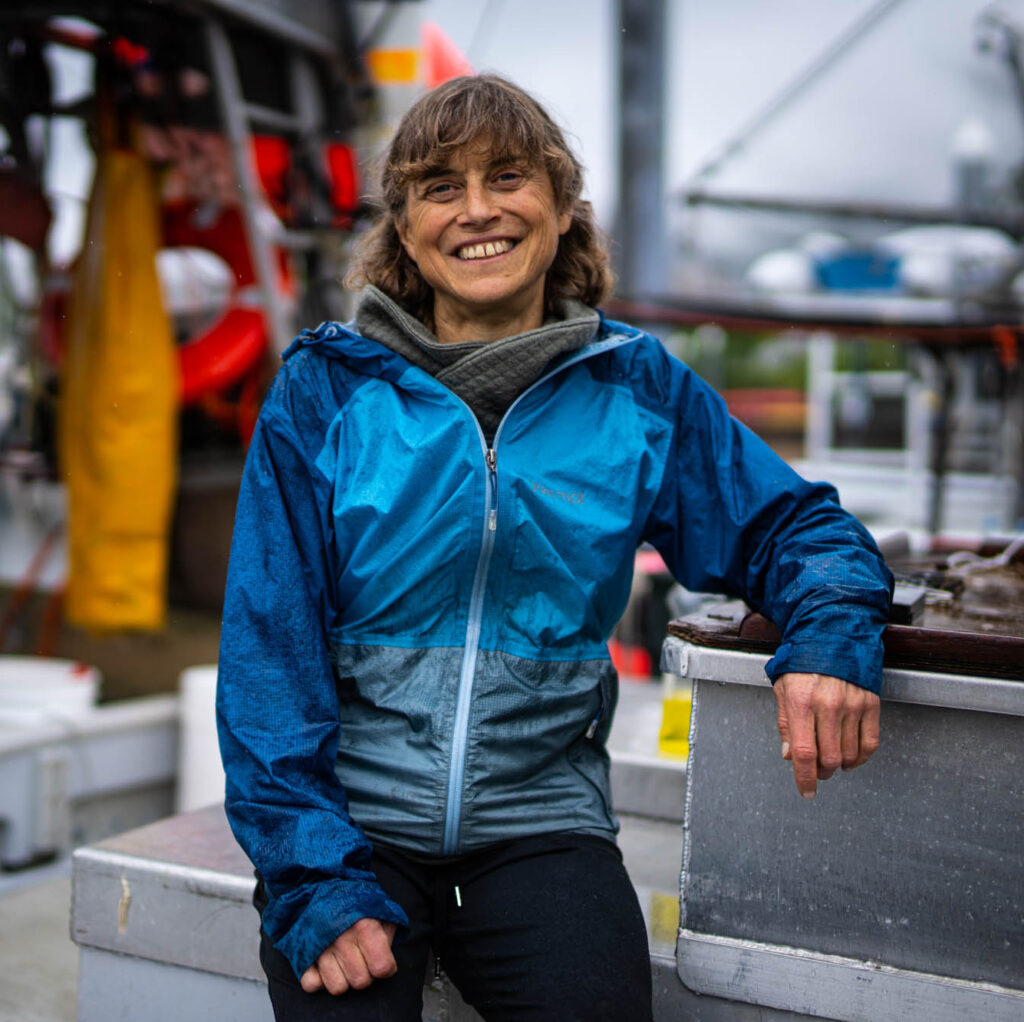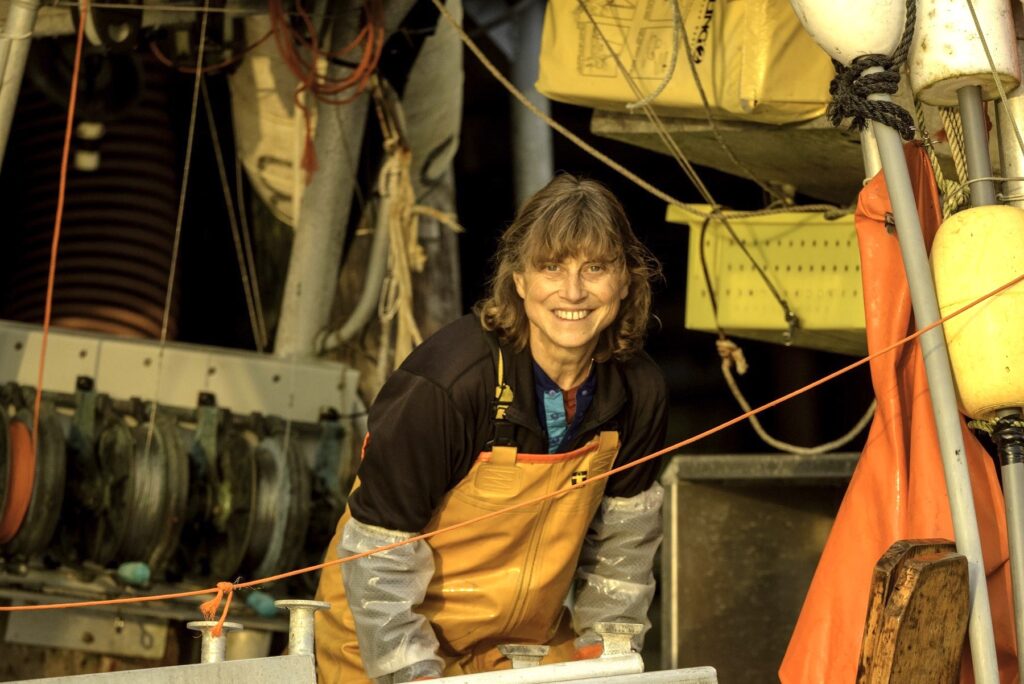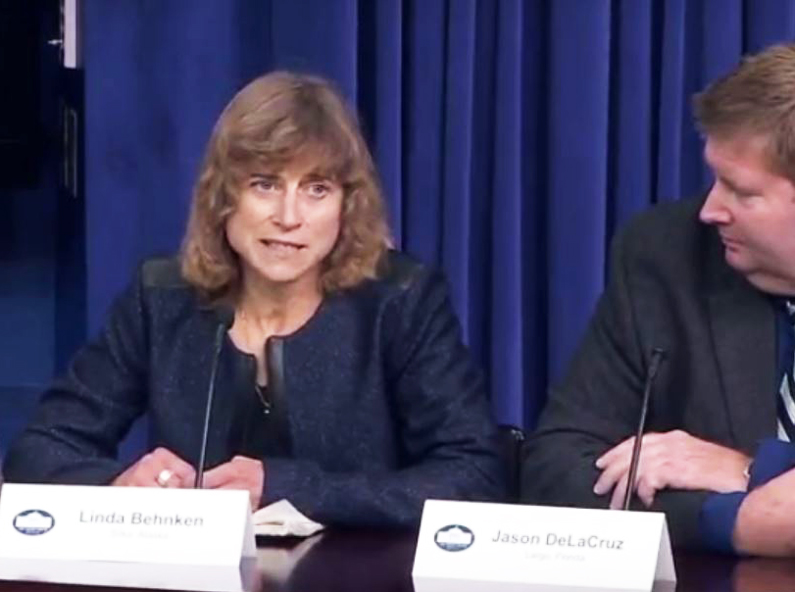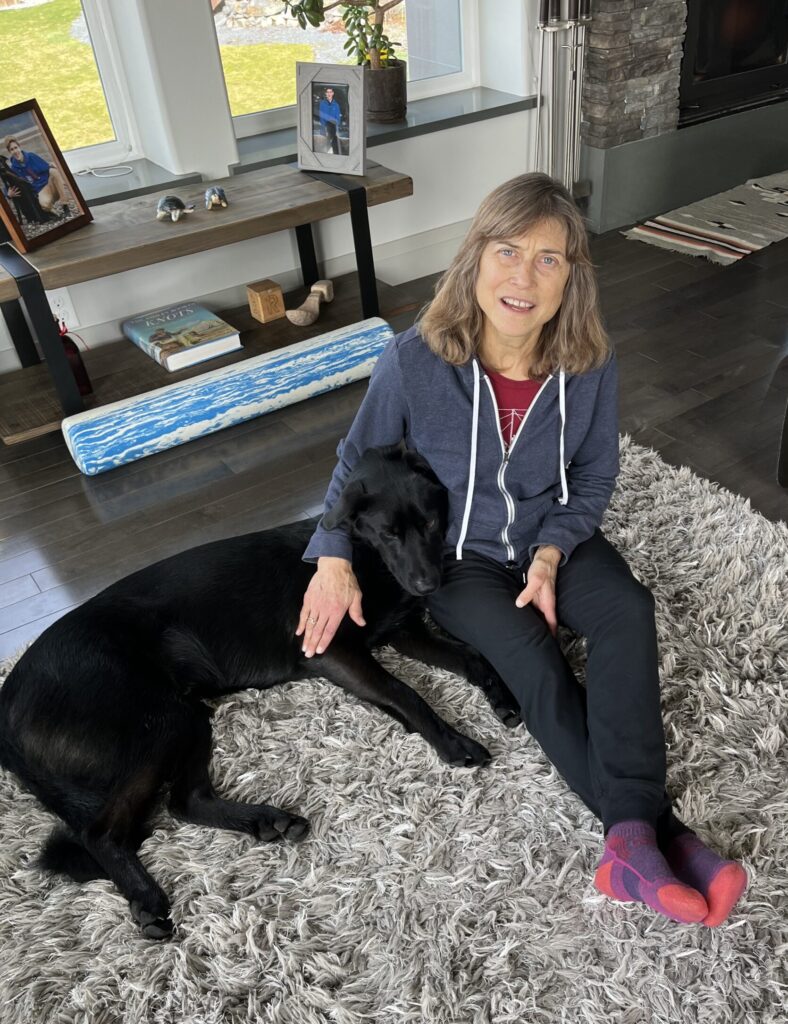Fishing and Sustainability: A Woman in the Forefront

Linda Behnken
The foremost expert on the topic of fishing and sustainability in Southeast Alaska might just be Sitka’s own Linda Behnken. Many in the state – and the country – would agree with this assessment. As a longtime commercial fisherman, executive director of The Alaska Longline Fishermen’s Association (ALFA) and “birth mother” of the Alaska Sustainable Fisheries Trust (ASFT), Behnken carries a lot of street – or wave – cred.
Behnken sees two significant challenges to sustainability. The first – and perhaps most daunting – of these is Climate Change.
Encompassing the threats of ocean acidification and ocean warming, climate change puts the entire marine ecosystem at risk. Especially “in your face” for Alaska’s small boat fishermen are the changes they have personally witnessed in salmon runs – changes in size, distribution, abundance. Behnken vocally supports the role of small boat fishermen in their role as bellwethers of climate change. One of the precepts of ALFA is “When your job is to feed people, you don’t look away when something challenges your ability to do it.”
ALFA researchers continue: “As ocean conditions change, we see ripple effects through our ocean habitat. Temperature, acidity and melting ice all play a part. Fish stocks move thousands of miles from their usual homes, droughts and high stream temperatures jeopardize salmon runs, smaller fish sizes decrease harvests, and acidification threatens the foundation of the food web.”
Behnken points to the 2020 Sea Bank Report for its scientific quantification of the Southeast Alaska ecosystem (and that of Bristol Bay). Dubbing this system the “Sea Bank” – because of its measurable economic resources, as well as “quality of life” benefits – the report talks about Alaska’s stunning “natural capital.”
“Coastal areas are the most economically productive ecosystems in the world – not only for coastal communities but also for national economies and global trade. Coastal systems like Sea Bank comprise only 8 percent of the planet’s surface but generate 43 percent of the global ecosystem economic value.”
Industrial Scale Fishing is the other major challenge that Behnken identifies.
First foreign, and more recently, American factory trawlers have literally scraped the bottom of the ocean. The Sea Bank report identifies bottom trawling as “the most destructive industrial fishery, producing the highest volumes of bycatch (the taking of non-targeted fish species) of any fishing gear. Bottom trawling in Alaska kills many non-target fish… high value species such as sablefish, halibut and Chinook salmon.”
While factory trawlers have been curtailed in Southeast Alaska waters (thanks largely to the 1990s efforts of people like Behnken), the practice continues, insufficiently regulated say many, in Bristol Bay and the Gulf of Alaska. The species mentioned above “migrate to Southeast Alaska waters and support numerous Southeast Alaska communities.”

Linda Behnken With Gear (from Heinz Award site)
Because fish are migratory, says Behnken, they are far from immune to the effects of factory trawling when they leave Southeast Alaska waters. One strategy she embraces is to underwrite the health and vigor of small-scale fishermen. For such efforts, Behnken received the 2020 Heinz Award for the environment. “My goal was to shine a bright light on small scale fishermen as stewards of ocean health.”
Heinz Foundation award presenters explained how Behnken’s work “has effectively demonstrated that by engaging fishermen in research, management and stewardship, both the viability of small-scale fisheries and the ecosystem upon which fishing communities depend can be strengthened and sustained for future generations.”
What tools do we have? – Some are contained within nature.
First of all, says Behnken, we have the tool of national policy, especially re: placing a price on carbon.
Then, she continues, there is an extraordinarily powerful and undervalued strategy of “nature-based” climate solutions such as Carbon Sequestration. The Sea Bank report discusses in detail the efficient sequestration of both blue (marine-based) and green (land-based) carbon. Such storage is naturally engineered by oceans, and especially estuaries, to pack away carbon.
“One of the most potentially valuable ecosystem services provided by Sea Bank salt marshes and eelgrass meadows is the significant atmospheric carbon (CO2) uptake and long-term carbon storage and sequestration. These coastal wetlands capture and store carbon… within the soil (and in) aboveground biomass such as leaves and stems, belowground biomass such as roots, and non-living biomass… These ecosystems also can store CO2 for longer periods of time than terrestrial ecosystems – once captured, carbon stored in coastal soils can remain in place for millennia, resulting in large carbon stocks.”
Neither should the ability of old growth (and recovering second-growth) forests to sequester green carbon be underestimated. This is not just some kind of hippie-bippie talk, the report implies. Seven of the top one hundred seafood ports in the United States are located in Alaska and rely on “services provided by Sea Bank biomes.” Again, the numbers are provided for pounds of fish harvested, value in the millions of dollars per port and ex-vessel income.
Forests such as the Tongass store carbon “…both above and below ground over time. Industrial logging is one of the major drivers of… biodiversity loss and undermines one of the most effective climate change mitigation strategies – the conservation of green carbon… Logging creates an initial release of CO2 into the atmosphere… Land use change, including logging, accounts for roughly a quarter of anthropogenic greenhouse gas emissions… (thus) reducing emissions from logging and other causes of forest degradation is as urgent as halting fossil fuel use.”

Behnken speaking about mentorship in fisheries at The White House. Photo from White House video. From 10/7/2016 APM piece by Liz Ruskin.
This is not a zero-sum equation, Behnken suggests. “You can have sustainable fisheries. You can have sustainable forestry.”
We can determine or influence policy re: allocation of the resource.
Small scale, community-based fishermen are one key to sustainability, Behnken contends, because they are committed to sustainable fisheries and work hard to keep the resource healthy. She goes on to say that maintaining access to local fisheries is critical to the health of Alaska’s coastal communities. To highlight that link to community health and food resilience, during the pandemic, ALFA and ASFT fishermen provided or distributed 630,000 seafood meals to families in need in Alaska and the Pacific Northwest.
During the pandemic, the message has been reinforced that, when it comes to fish-in-the-ocean as a source of food, the resource is not infinite. A central part of the solution lies in allocation. Commercial fisheries ARE food security and community resilience. While tourist/charter fishing was shut down during the pandemic, commercial fishermen were quickly identified as an essential service and kept working hard while taking strict precautions.
Behnken says that assistance with resource allocation can come from such places as U.S. Dept. of Agriculture Regional Food System Partnerships. RFSP grants look to increase food security in Alaska while building community across the state – Alaskans helping Alaskans to cope with climate change and with declining salmon runs in response to climate change.
“We know that salmon sustains and connects Alaskans – our goal will be to support culture and community health by sharing salmon,” Behnken summarizes. Another important tactic, she suggests, will be to promote value-added processing in Alaska, better utilization of seafood, and work force development with RFSP grants.
The focused work of ALFA has also embraced modern technical tools. Again, from the Heinz Award:
“ALFA’s bathymetric mapping project has generated detailed seafloor maps to help fishermen minimize the catch of non-target fish. ALFA also helped launch the Southeast Alaska Sperm Whale Avoidance Project, which aims to reduce interactions between fishing boats and sperm whales through satellite-tagging, towed arrays, and fishermen reports.”

Behnken at home with friend, March 2022. (Photo by S. Portello)
Looking to the future – What can we do as individual food eaters, fishermen, fish waste generators?
“We can lower the carbon footprint of the food we eat, for example, by localizing our food supply and electrifying the fishing fleet.” The personal choices we make, the food we eat – it is important to know where it comes from. Look for a community supported fishery in your local area. “Anybody who buys fish should know where it comes from,” says Behnken. “That disclosure needs to be there.”
Make the shift away from petroleum-dependent power, by electrification of the fishing fleet. But this must be done over time; the process of electrification needs to go through a hybrid stage first, because fishermen are pragmatic people – they need to see tangible results, says Behnken. But the technology is here – we are just looking for funding. She adds, “The pilot (project) is always the most expensive step.”
Regarding disposal of “fish waste” – we need to look critically at the whole concept of “waste” – what is that? Just something to just be “disposed of”? Or could it be part of the pattern of re-purposing, too? Up until now, there has not been enough volume to support a large-scale local composting operation – that could change in the future, she says. Then, we need to explore the concept of biofuels. She suggests that the Sitka Conservation Society may be doing some research on this.
Why are women in the forefront of sustainability?
“Women are often (in the habit of) thinking about the next generation a lot,” notes Behnken drily.
—
About Linda Behnken from The Woodrow Wilson Center for International Scholars – https://www.wilsoncenter.org/person/linda-behnken
Linda Behnken has been a commercial fisherman in Alaska since 1982, and currently fishes with her spouse and their two sons on their 38-foot boat. She served on the North Pacific Fishery Management Council (NPFMC) from 1992-2001, when she also served as an industry advisor to the North Pacific Anadromous Fish Commission and the National Academy of Science Individual Fishing Quota Review Panel.
Linda helped launch the Alaska Sustainable Fisheries Trust, which invests in fishing access opportunities for community-based fishermen committed to sustainable fishing practices, and Alaskan’s Own, the first Community Supported Fisheries program in Alaska.
She served as a U.S. Commissioner to the International Pacific Halibut Commission from 2016-2018 and as a member of Alaska’s Climate Action Leadership Team. In 2009 she was awarded the National Fisherman Highliner award for her work promoting healthy marine ecosystems and strong coastal communities. In 2016 she was recognized as a White House Champion of Change for Sustainable Seafood by President Obama, and in 2020 was awarded the Heinz Foundation Award for the Environment.
She has BA from Dartmouth College and a Master’s in Environmental Science from Yale University.
Websites & articles consulted for “Fishing & Sustainability: A Woman in the Forefront”
Heinz Award: https://www.heinzawards.org/pages/linda-behnken
NextPittsburgh.com: https://nextpittsburgh.com/latest-news/from-sustainable-fishing-to-maternal-health-the-heinz-awards-recognize-those-solving-big-problems-this-year-women-won-big/
Alaska Sustainable Fisheries Trust (ASFT): https://thealaskatrust.org/
2020 Sea Bank Annual Report: https://drive.google.com/file/d/1TSHVcsQ4YY4tDLp49JNQrS-LiiWh_zSy/view
Alaska Longline Fishermen’s Association (ALFA) Climate Solutions page: https://www.alfafish.org/climate-solutions
